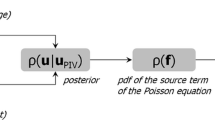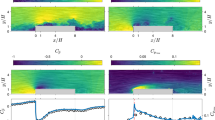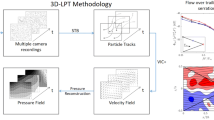Abstract
Three-dimensional time-resolved velocity field measurements are obtained using a high-speed tomographic Particle Image Velocimetry (PIV) system on a fully developed flat plate turbulent boundary layer for the estimation of wall pressure fluctuations. The work focuses on the applicability of tomographic PIV to compute the coherence of pressure fluctuations, with attention to the estimation of the stream and spanwise coherence length. The latter is required for estimations of aeroacoustic noise radiation by boundary layers and trailing edge flows, but is also of interest for vibro-structural problems. The pressure field is obtained by solving the Poisson equation for incompressible flows, where the source terms are provided by time-resolved velocity field measurements. Measured 3D velocity data is compared to results obtained from planar PIV, and a Direct Numerical Simulation (DNS) at similar Reynolds number. An improved method for the estimation of the material based on a least squares estimator of the velocity derivative along a particle trajectory is proposed and applied. Computed surface pressure fluctuations are further verified by means of simultaneous measurements by a pinhole microphone and compared to the DNS results and a semi-empirical model available from literature. The correlation coefficient for the reconstructed pressure time series with respect to pinhole microphone measurements attains approximately 0.5 for the band-pass filtered signal over the range of frequencies resolved by the velocity field measurements. Scaled power spectra of the pressure at a single point compare favorably to the DNS results and those available from literature. Finally, the coherence of surface pressure fluctuations and the resulting span- and streamwise coherence lengths are estimated and compared to semi-empirical models and DNS results.















Similar content being viewed by others
Notes
The vector spacing for PIV is one quarter the interrogation element size (overlap factor 75 %).
References
Amiet R (1976) Noise due to turbulent flow past a trailing edge. J Sound Vib 47(3):387–393
Astarita T (2007) Analysis of weighting windows for image deformation methods in PIV. Exp Fluids 43(6):859–872
Atkinson C, Coudert S, Foucaut J-M, Stanislas M, Soria J (2011) The accuracy of tomographic particle image velocimetry for measurements of a turbulent boundary layer. Exp Fluids 50(4):1031–1056
Bernardini M, Pirozzoli S (2011) Wall pressure fluctuations beneath supersonic turbulent boundary layers. Phys Fluids 23(8):085102
Brooks TF, Hodgson TH (1981) Trailing edge noise prediction from measured surface pressures. J Sound Vib 78(1):69–117
Bull MK (1967) Wall-pressure fluctuations associated with subsonic turbulent boundary layer flow. J Fluid Mech 28(4):719–754
Bull MK (1996) Wall-pressure fluctuations beneath turbulent boundary layers: some reflections on forty years of research. J Sound Vib 190(3):299–315
Buschmann MH, Gad-el-Hak M (2003) Debate concerning the mean-velocity profile of a turbulent boundary layer. AIAA J 41(4):565–572
Charonko JJ, King CV, Smith BL, Vlachos PP (2010) Assessment of pressure field calculations from particle image velocimetry measurements. Meas Sci Technol 21(10):105401
Christophe J (2011) Application of hybrid methods to high frequency aeroacoustics, PhD thesis, Université libre de Bruxelles
Clauser FH (1956) The turbulent boundary layer. Adv Appl Mech 4:1–51
Corcos GM (1964) The structure of the turbulent pressure field in boundary-layer flows. J Fluid Mech 18(3):353–378
de Kat R (2012) Instantaneous planar pressure determination from particle image velocimetry, PhD thesis, Delft University of Technology
de Kat R, van Oudheusden BW (2012) Instantaneous planar pressure determination from PIV in turbulent flow. Exp Fluids 52(5):1089–1106
Efimtsov BM (1982) Characteristics of the field of turbulent wall pressure flucuations at large Reynolds numbers. Sov Phys Acoustics 28(4):289–292
Elsinga GE, Scarano F, Wieneke B, van Oudheusden BW (2006) Tomographic particle image velocimetry. Exp Fluids 41(15):933–947
Ghaemi S, Scarano F (2010) Multi-pass light amplification for tomographic particle image velocimetry applications. Meas Sci Technol 21(12):127002
Ghaemi S, Ragni D, Scarano F (2012) PIV-based pressure fluctuations in the turbulent boundary layer. Exp Fluids 53(6):1823–1840
Goody MC (2004) Empirical spectral model of surface pressure fluctuations. AIAA J 42(9):1788–1794
Graham WR (1997) A comparison of models for the wavenumber-frequency spectrum of turbulent boundary layer pressures. J Sound Vib 206(4):541–565
Howe MS (1999) Trailing edge noise at low mach numbers. J Sound Vib 225(2):211–238
Hwang YF, Bonness WK, Hambric SA (2009) Comparison of semi-empirical models for the turbulent boundary layer wall pressure spectra. J Sound Vib 319:199–217
Koschatzky V, Moore PD, Westerweel J, Scarano F, Boersma BJ (2011) High speed PIV applied to aerodynamic noise investigation. Exp Fluids 50(4):863–876
Liu X, Katz J (2006) Instantaneous pressure and material acceleration measurements using a four-exposure PIV system. Exp Fluids 41(2):227–240
Lorenzoni V, Tuinstra M, Scarano F (2012) On the use of time-resolved particle image velocimetry for the investigation of rod-airfoil aeroacoustics. J Sound Vib 331(23):5012–5027
Morris SC (2011) Shear-layer instabilities: particle image velocimetry measurements and implications for acoustics. Ann Rev Fluid Mech 43(1):529–550
Palumbo D (2012) Determining correlation and coherence lengths in turbulent boundary layer flight data. J Sound Vib 331(16):3721–3737
Pirozzoli S (2010) Generalized conservative approximations of split convective derivative operators. J Comput Phys 229(19):7180–7190
Pirozzoli S (2012) On the size of the energy-containing eddies in the outer turbulent wall layer. J Fluid Mech 702:521–532
Ragni D, Oudheusden BW, Scarano F (2011) 3D pressure imaging of an aircraft propeller blade-tip flow by phase-locked stereoscopic PIV. Exp Fluids 52(2):463–477
Robinson S (1991) Coherent motions in the turbulent boundary layer. Ann Rev Fluid Mech 23(1):601–639
Schewe G (1983) On the structure and resolution of wall-pressure fluctuations associated with turbulent boundary-layer flow. J Fluid Mech 134:311–328
Schröder A, Geisler R, Elsinga GE, Scarano F, Dierksheide U (2008) Investigation of a turbulent spot and a tripped turbulent boundary layer flow using time-resolved tomographic PIV. Exp Fluids 44(2):305–316
Sciacchitano A, Scarano F, Wieneke BG (2012) Multi-frame pyramid correlation for time-resolved PIV. Exp Fluids 53:1087–1105
Theunissen R, Scarano F, Riethmuller ML (2008) On improvement of PIV image interrogation near stationary interfaces. Exp Fluids 45(4):557–572
Violato D, Moore P, Scarano F (2011) Lagrangian and Eulerian pressure field evaluation of rod-airfoil flow from time-resolved tomographic PIV. Exp Fluids 50(4):1057–1070
Welch P (1967) The use of fast Fourier transform for the estimation of power spectra: a method based on time averaging over short, modified periodograms. IEEE Trans Audio Electroacoustics 15(2):70–73
Wieneke B (2008) Volume self-calibration for 3D particle image velocimetry. Exp Fluids 45(4):549–556
Acknowledgments
This research is supported by the European Community’s Seventh Framework Programme (FP7/2007–2013) under the AFDAR project (Advanced Flow Diagnostics for Aeronautical Research). Grant agreement No.265695. The authors acknowledge the Italian computing center CINECA for the availability of high performance computing resources and support through the 2010-2011 ISCRA Award.
Author information
Authors and Affiliations
Corresponding author
Additional information
This article is part of the Topical Collection on Application of Laser Techniques to Fluid Mechanics 2012.
Rights and permissions
About this article
Cite this article
Pröbsting, S., Scarano, F., Bernardini, M. et al. On the estimation of wall pressure coherence using time-resolved tomographic PIV. Exp Fluids 54, 1567 (2013). https://doi.org/10.1007/s00348-013-1567-6
Received:
Revised:
Accepted:
Published:
DOI: https://doi.org/10.1007/s00348-013-1567-6




